Monastic sites differed not only in their size and number of their lamas, the circumstances of their foundation, and their arrangements or layouts, but also in their specific functions. These included the types of temples and monastic colleges they had and thus the ceremonial and training specialities.
Temples
Depending on their size, monasteries had a number of different dugan or süm, temples or shrines (Mong. duγang, Tib. ’du-khang, Mong. süme), all having their own assembly, daily chanting, special monthly and annual rituals, and connected training. There was a tsogchin, main assembly hall (Mong. čoγčin, Tib. tshogs-chen) in every monastery. Daily chanting, called similarly tsogchin, was held there, and it housed the gol shüteen, main object of veneration (Mong. γool sitügen, Tib. rten gtso-bo) of the monastery on its altar. Due to its size, it was also suitable to accommodate all lamas of the monastery at special occasions or rituals. The other temples, dedicated to different rituals or specific deity practices, as in Tibet, bore the names of these deities, their main objects of veneration placed in the temple, or were named after their specific functions and rituals.
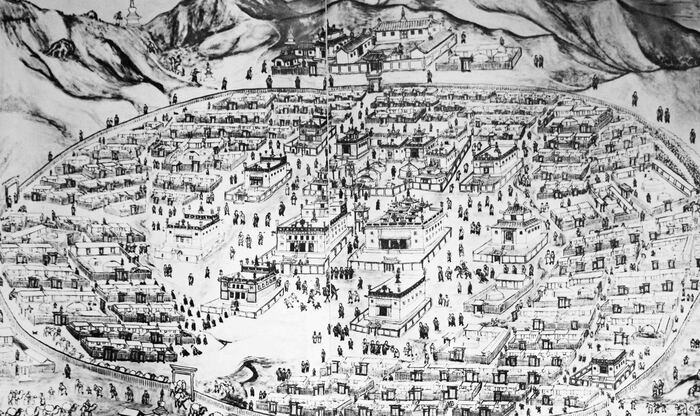
If there were only two temples in a monastery, the other was usually the temple dedicated to the protector or protectors of the monastery. It was called sakhiusny dugan, protector temple (Mong. sakiγu(l)sun-un duγang) or arwan khangalyn dugan, temple of the ten fierce ones (Mong. arban qangγal-un duγang). In Mongolian, there are different terms for Dharma protectors, namely sakhius or nomyn sakhius (Mong. (nom-un) sakiγu(l)sun, Tib. srung-ma / bstan-bsrung, chos-srung, chos-skyong, Skt. (dharma)pāla), and two other terms related to their wrathful aspect, khangal, “untamed, wild, fierce one” (Mong. qangγal, Tib. drag-po, Skt. raudra) and dogshid, plural of dogshin, “fierce destroyer” (Mong. doγsid, Tib. drag-gshed). The latter term is the name for the group of eight wrathful deities protecting the Buddhist teachings in Tibet, but in Mongolian Buddhism it refers to the group of ten such deities that are specially venerated, the arwan sakhius, the ten protectors, or arwan khangal or arwan dogshid, the ten ferocious ones. This explains the term “arwan khangalyn dugan” often used for these temples.
In larger monasteries there were other temples dedicated to the practices of different deities, such as:
- Dar’ ekh, Tārā (Mong. dar-a eke, Tib. sgrol-ma)
- Manal, Medicine Buddha (Mong. manal / man lha, Tib. sman-bla, Skt. Bhaiṣajyaguru)
- Maidar, Maitreya (Mong. maidari, Tib. byams-pa)
- Janraiseg, Avalokiteśvara (Mong. ǰanrayisig, Tib. spyan-ras-gzigs)
- Awid, Amitābha (Mong. abida, Tib. ’od dpag-med)
- Zuu, Buddha (Mong. ǰuu, Tib. jo-bo, “Lord”), referring to an image of Buddha Shakyamuni.
These temples were called respectively Dar’ ekhiin dugan (or süm), Manalyn dugan, Maidaryn dugan, Janraisegiin dugan, Awidiin dugan, and Zuugiin dugan.
Larger monasteries might also have had a Ganjuur temple, Kangyur temple (Mong. ganǰuur, Tib. bka’-’gyur, the translated enlightening words of the Buddha) called Ganjuuryn dugan, housing the volumes of the Kangyur. They might also have had as well temples dedicated to various other special rituals, such as:
- Günreg, Sarvavidyā (Vairocana) (Mong. günrig, Tib. kun-rig(s) [rnam-par snang- mdzad])
- Sandui, Guhyasamāja (Mong. sangdui, Tib. gsang-’dus)
- Lamyn chodow, Guru Pūja (Mong. lam-a / blam-a-yin čodba, Tib. bla-ma mchod-pa), the Gelug ritual of “Offering to the Spiritual Masters”
- Nünnei / Nügnee, abiding in fasting (Mong. nüngnei, Tib. smyung-gnas), the fasting retreat associated with Avalokiteśvara;
- Khailen or yar khailen, (summer) commitments (Mong. (yar) qayilan, Tib. (dbyar) khas-len), for the summer retreats of the monastics
- Dünshig, admission of downfalls (Mong. düngšig, Tib. ltung-bshags) before the thirty-five Buddhas.
These were called respectively Günregiin dugan, Sanduin dugan, Lamyn chodwyn dugan, Nügnein or Nünnein dugan, Khailengiin dugan, and Dünshigiin dugan.
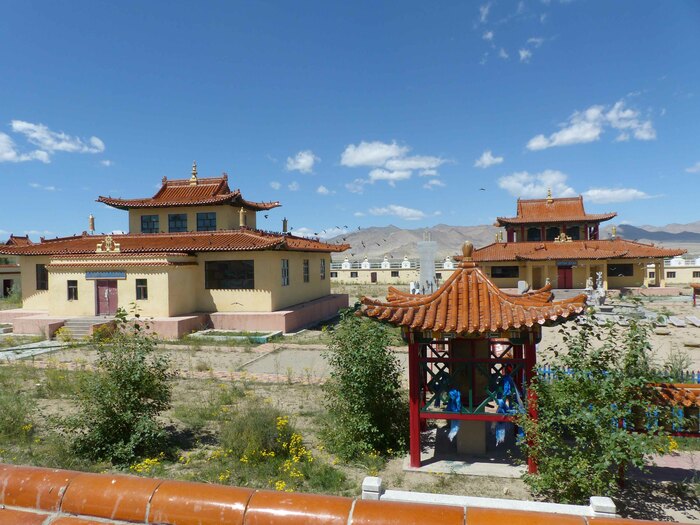
In a very few cases, there were zod or jod, “cutting through” ego-clinging temples of the tantric chö system (Mong. ǰod, Tib. gcod) inside the monasteries themselves. In these exceptional cases, female practitioners also belonged to and gathered in them, together with the male tantric practitioners, within the monastery; otherwise, this was not the case. In the monasteries, it was usually the Lamrim datsan (Mong. lamarim dačang, Tib. lam-rim grwa-tshang) in which zoch lamas, lamas who performed the zod rituals (Mong. ǰoči, Tib. gcod-pa) gathered, since the Lamrim datsan was usually a place of exorcism and served as a specialist temple where gürem, protective healing rituals (Mong. gürim, Tib. sku-rim) were performed. Such temples could also have born the name Gürem datsan. Otherwise, zod assemblies were held outside or near the monasteries, with sometimes even more than one zoch master having their individual temples near a monastic site.
These temples were the most frequently found ones in the majority of Mongolian monasteries, though Nyingma ones had other types as well, named after their specific practices.
Specialized Monastic Colleges
In addition to a variety of the above temples, datsan, specialized monastic colleges (Mong. dačang, Tib. grwa-tshang) operated in the larger monasteries and monastic cities. They specialized in philosophical, medical, astrological, graded path, Kālacakra or tantric studies and, in several cases, annual exams could be taken in them in the given subjects. The most usual and most important was the choir datsan, “Dharma college,” the monastic college for philosophy (Mong. čoyir-a dačang, Tib. chos-grwa grwa-tshang), also called tsanid datsan, the monastic college for debate (Mong. čanid dačang, Tib. mtshan-nyid grwa-tshang). Different damjaa exams (Mong. damǰiya, Tib. dam-bca’) in philosophical studies could be taken regularly there after one finished the required years of study. These exams included the domyn damjaa, the exam on the condensed summary texts (Mong. dom-un damǰiya, Tib. sdom-pa’i dam-bca’) and gawjiin damjaa, the exam on the ten difficult texts (Mong. γabǰu / γabǰi-yin damǰiya, Tib. dka’-bcu’i dam-bca’), being texts on the five major subjects of Buddhist philosophy and their commentaries for receiving academic degrees in philosophical studies.
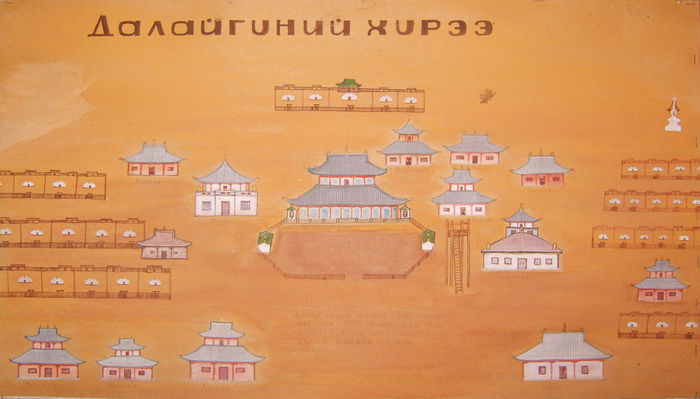
Each of these philosophical monastic colleges used one of three sets of different manuals or textbooks (igchaa, Mong. iγča, Tib. yig-cha) used in the monastic colleges of different Tibetan Gelug monasteries, and thus they followed their different systems. These three textbook traditions were:
- The Gomang textbooks, goman igchaa (Mong. γoman iγča, Tib. sgo-mang yig-cha) or Kunkhyen textbooks, günchin igchaa (Mong. günčin iγča, Tib. kun-mkhyen yig-cha). These are the philosophical texts of the Gomang college, Goman datsan (Mong. γoman dačang, Tib. sgo-mang grwa-tshang) of Drepung monastery (Khal. drepung goman datsan, Mong. drepung γoman dačang, Tib. ’bras-spungs sgo-mang grwa-tshang) and were written by Kunkhyen Jamyang Shepa (Khal. Günchin jamiyaan shadaw, Tib. Kun-mkhyen ’Jam-dbyangs bzhad-pa, 1648–1721). In the monastic capital, Dashchoimbel datsan (Tib. bkra-shis chos-’phel grwa-tshang) followed this set of textbooks.
- The Loseling textbooks, losalin igchaa (Mong. losalin iγča, Tib. blo-gsal-gling yig-cha) or Panchen textbooks, Wanchin igchaa (Mong. pangčin iγča, Tib. pan-chen yig-cha). These are the textbooks of Loseling college, Losalin datsan (Mong. losalin dačang, Tib. blo-gsal-gling grwa-tshang) of Drepung monastery (Khal. drepung losalin datsan, Mong. drepung losalin dačang, Tib. ’bras-spungs blo-gsal-gling grwa-tshang) and were written by Panchen Sonam Drakpa (Khal. Wanchin Sodnomdagwa, Tib. pan-chen bsod-nams grags-pa, 1478–1554). In the monastic capital, Güngaachoilin datsan (Tib. kun-dga’ chos gling grwa-tshang) followed this set of textbooks.
- The Sera textbooks, seriin igchaa (Mong. sera-yin iγča, Tib. se-ra yig-cha), called in Tibet the Jetsunpa textbooks (Tib. rje-btsun-pa yig-cha). These are the textbooks of Sera Je college (Khal. ser je / sera je, Mong. sera ǰe, Tib. se-ra byes) of Sera monastery and were written by Jetsunpa Chokyi Gyaltsen (Khal. Jewtsün Choinji Jaltsan, Tib. rJe-btsun Chos-kyi rgyal-mtshan, 1469–1544). In the monastic capital, Idgaachoinzinlin datsan (Tib. yid-dga’ chos-’dzin gling grwa-tshang) followed this set of textbooks.
The larger monasteries also had other monastic colleges, such as:
- Manba or Mamba datsan, medical colleges (Mong. mamba dačang, Tib. sman-pa grwa-tshang)
- Zurkhai datsan, astrological colleges (Mong. ǰiruqai dačang, Tib. rtsis-pa grwa-tshang)
- Lamrim datsan, graded path colleges (Mong. lamarim dačang, Tib. lam-rim grwa-tshang)
- Jüd datsan, tantric colleges (Mong. ǰüd(ba) dačang, Tib. rgyud grwa-tshang) or Awag or Agwa datsan, mantra colleges (Mong. aγba dačang, Tib. sngags-pa grwa-tshang)
- Düinkhor datsan, Kālacakra colleges (Mong. düyingqor dačang, Tib. dus-’khor grwa-tshang).
All of them could be found in the largest monasteries. Other exams could be taken in them after finishing the specialized studies – for example, the agramba or agrimba exam (Mong. aγrimba, Tib. sngags-rams-pa) in the tantric colleges and the maaramba exam (Mong. maramba, Tib. sman-rams-pa) in the medical colleges. These studies, however, were more rarely available than philosophical training.
Kālacakra was especially widespread in Mongolia due to the popularity among the Mongols of the myths concerning Shambhala, a kingdom associated closely with this tantra. Thus, many monasteries had these Düinkhor colleges for the study of Kālacakra, as well as Zurkhai astrological and Manba medical colleges since these branches of Buddhist sciences are also connected to these teachings. Irrespective of the number and types of monastic colleges and thus specialized training possibilities that were available in any given monastery, every middle-sized monastery had at least a resident otoch / emch, doctor (Mong. otači / emči, Tib. sman-pa) and zurkhaich, astrologer (Mong. ǰiruqayiči, Tib. rtsis-pa). Gawj monks – monks who had taken the gawjiin damjaa exam in philosophy – were held in especially high esteem in all assemblies.
Other Monastery Buildings
Books were printed in some monasteries and some monasteries were famous for their printing art techniques or for the special paints they used – for example, coral for printing in red letters or the yesön erdene, nine jewels (Mong. yisün /yesün erdeni) – namely, gold, silver, iron, copper, seashell, turquoise, lapis lazuli, coral, and pearl. Only some large monastic cities, however, had a separate printing house, which was called barkhan (Mong. barqang, Tib. par-khang).
Apart from the temples and monastic colleges, monasteries had various other buildings as well, such as those serving administrative purposes or residential or kitchen buildings. In larger monasteries, each temple or monastic college had a separate building for its own economic unit, called jas, “general reserves” (Mong. ǰisa, Tib. spyi-gsog), while smaller monasteries had only some or one such economic unit and its buildings. In case a monastery had only one economic unit, it bore the name ikh jas, main economic unit (Mong. yeke ǰisa). The treasury of the khutugtu was called differently, as san (Mong. sang).
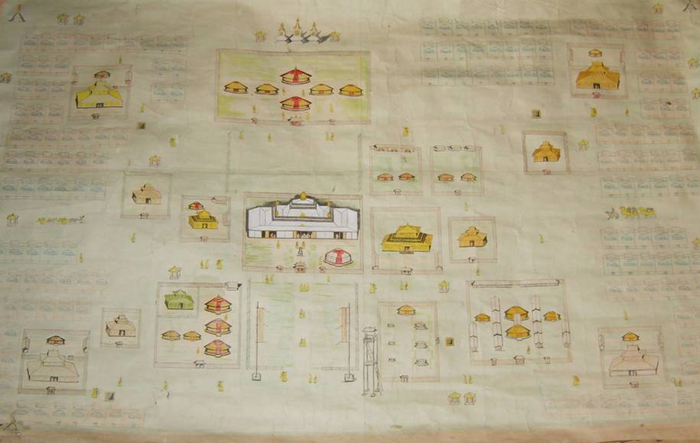
Stupas, called in Mongolian suwraga (Mong. suburγan, Tib. mchod-rten, Skt. stūpa), stood inside or near the monastic sites, like the burkhan bagshiin naiman suwraga, the eight stupas of the Buddha (Mong. burqan baγši-yin naiman suburγan, Tib. (sangs-rgyas-kyi) mchod-rten (cha) brgyad, Skt. aṣṭa stūpāḥ), representing the eight important events of the life of Shakyamuni Buddha. This group of eight stupas were found sometimes in a row on the north of the monastery. Other stupas might have stood at the four sides of the complex or scattered around it. There were also khürd, large prayer wheels (Mong. kürdün), often in small wooden buildings on the goroo or gorlom, the circumambulation path (Mong. γoroγ-a, Tib. skor; Mong. γorlam, Tib. skor-lam) around the monastery or around the temples.
The residences of the head of the monastery and of khutagt (khutugtu) (Mong. qutuγtu, transliterated in Tibetan as ho-thog-tu, Tib. ’phags-pa, Skt. ārya; Highly Realized One, Noble One) and khuwilgaan (khubilgan) (Mong. qubilγan, Tib. sprul sku, Skt. nirmāṇakāya) could be a larger yurt within a courtyard or even a small palace situated anywhere within the monastery complex or, more often, built separately nearby. These residences were called lawran (Mong. labrang, Tib. bla-brang) or by their Mongolian name, ordon (Mong. ordon), both meaning “palace.”
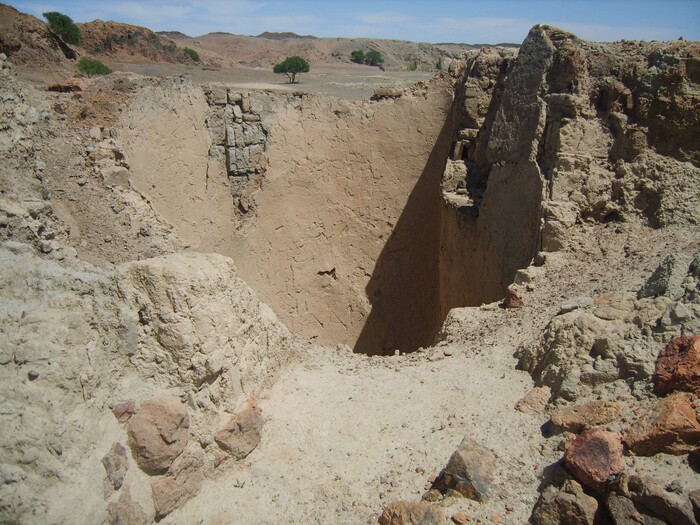
In the case of monastery buildings made of brick, there was one or several baayuu, kilns, (Mong. bayuu, Chin. wă yáo) nearby where blue or grey bricks were fired. Such kilns consisted of a huge hole, 1.5 to 8 or 10 meters in diameter, in the earth with walls made of brick or mud. Sometimes, there was more than one kiln at a site. In them, several 100 or even 10,000 bricks could be fired at once. Sun-dried bricks could be produced anywhere near but outside the monastery site, near some source of water, well or river. Litter, mainly bones and other waste material, was disposed of usually a bit far, about 100 metres from the monastic site in the southeast to avoid the bad smell reaching the monastery.
In all cases, laypeople were not allowed to live within the monastery or monastic city, but only nearby. Thus, they resided around larger monasteries in separate lay quarters on their outskirts. There were also small, separate Chinese settlements of construction workers and traders with Chinese stores next to larger monasteries.
Schools of Buddhism and Their Monasteries
In Mongolian, besides the general expression burkhany shashin, the religion of Buddha (Mong. burqan-u šašin / šaǰin), the term sharyn shashin (Mong. sir-a-yin šašin / šaǰin) is often used in general for Buddhism even though it literally means “yellow religion” referring to the shar malgaitan, the Yellow Hat School (Mong. sir-a malaγai-tan, Tib. zhwa-ser-ba; “those with yellow hats”) – namely, gelüg(wa), Gelug(pa) (Mong. gelüg(pa), Tib. dge-lugs(-pa)). The term ulaan shashin, red religion (Mong. ulaγan šašin / šaǰin) or ulaan yos, red tradition (Mong. ulaγan yosun), and ulaan ursgal, red stream or red school (Mong. ulaγan urusqal), also exists for the nima(wa), Nyingma school (Mong. nima(pa), Tib. rnying-ma(-pa)), also known as ulaan malgaitan, the Red Hat school (Mong. ulaγan malaγai-tan, Tib. zhwa-dmar-ba; “those with red hats”), but, on the contrary, this is never used in general for Buddhism. This is because although other schools had played a great role in the spread of Buddhism in Mongolia from the 13th century – like the saja(wa), Sakya school (Mong. saǰ-a / saǰaba, Tib. Sa-skya(-pa)) and the garma garjid / garjüd, Karma Kagyü school (Mong. γarma γarǰüd(ba) / γarǰid(ba), Tib. kar-ma bka’-brgyud) of garjid(wa) / garjüd(wa), Kagyü (Mong. γarǰüd(ba) / γarǰid(ba), Tib. bka’-brgyud(-pa)), also called khar malgait or shanag(pa), Black Hat school (Mong. qar-a malaγai-tan, Tib. zhwa-nag(-pa), “those with black hats”) after the black hat of the Karmapas – yet from the 17th century, after the Manchus came to power, and especially during Öndör Gegeen Zanabazar’s time (1635–1723), the teachings of the Gelugpa school became extremely dominant in the area of today’s Mongolia. In relation to the monasteries, this meant that although other schools, mainly Nyingma, also had monasteries in Mongolia, and similarly Sakya, Kagyü and Nyingma were all present in Ikh khüree as well where Öndör Gegeen Zanabazaar founded separate temples for these other schools in the various different aimag, monastic districts (Mong. ayimaγ), still almost all large monastic cities were Gelug. For this reason, several of the temple types and monastic colleges in the above description of the types of temples found in Mongolian monasteries are characteristic of the Gelug tradition.
There existed, however, several important Nyingma monasteries in the country, mainly the monasteries of certain incarnate lamas of the Nyingma school, for example Khüükhen khutagtiin khüree in Khentii province and Noyon khutagtiin khüree in Dornogow’ province, and also many smaller assemblies, although the small Gelug assemblies outnumbered these as well. It seems that only Erdene zuu (Mong. Erdeni ǰuu, Öwörkhangai province, Kharkhorin), which was the first monastery in Mongolia, and several smaller assemblies kept some practices of or followed the views of the Sakya school. There existed some Kagyü assemblies as well. Zoch tantric masters followed different lineages in their assemblies near the monasteries or in some cases even inside. In certain monasteries, high-ranking lamas of the assemblies were at the same time zoch tantric masters, as Gelug and zod systems do not preclude each other.
There was no residential nunnery in the area of Mongolia in the pre-1937 period at all, as there was no tradition of nuns, not even novice nuns. In Mongolian, emegtei lam (Mong. emegtei lam-a / blam-a) and ane / ani (Mong. ani, Tib. a-ne / a-ni) are used in general for female members of the monastic community, irrespective of the level of vows. Female practitioners belonged only to zod tantric assemblies, which only exceptionally operated within large monastery complexes.
Monasteries and Temples of Chinese and Other Nations, and Religions in Mongolia
Large merchant centers where a considerable Chinese colony lived also had Chinese Buddhist temples. These centers included Ikh khüree, Uliastai (Mong. uliyasutai) in today’s Zawkhan province, Khowd (Mong. qobdo) in today’s Khowd province, and Khyagt (Khyakhta) in today’s Republic of Buryatia, Russia, on the border of Buryatia and Mongolia opposite the Mongolian town Altanbulag (Mong. altanbulaγ). Some of the larger monastic towns or cities also had Chinese Buddhist temples, such as Zaya gegeenii khüree in today’s Arkhangai province center, Tsetserleg and Daichin wangiin khüree in today’s Bulgan province center.
Orthodox churches were also found in Ikh khüree and Khyagt due to the presence of Russians in large number. A Chinese Muslim mosque as well as other Chinese temples were also found in Ikh khüree.
There were two types of specific temples that operated mainly in Chinese districts or Chinese settlements around monastic cities. One of them was the so-called Geser (Mong. gesar, Tib. ge-sar) temples, named after an epic hero of the same name, known also as King of Ling (Tib. gling) in Tibetan and Mongolian literature. His figure in Mongolia became fused, however, with Guān yŭ or Guān dì, “Emperor Guān,” the Chinese war god who is venerated in Confucianism, Daoism and Chinese Buddhism as well. He was a historical person, a renowned general of the Three Kingdoms Period (220–280 C.E.), who later became venerated as a god of war and protector of China. Thus, during the reign of the Manchu Qing dynasty (1636–1912), his cult was utilized in the hope of helping the new dynasty to defeat its enemies and to expand its territory. With this aim, several monasteries were founded for his veneration and thus the name Geser süm (Mong. gesar süme) was frequently met for these Chinese temples in larger settlements in Mongolia with Chinese inhabitants. These were, in fact, Chinese Buddhist temples and had as their main object of veneration Chinese-style sculptures of Guān dì, not modelled after the Tibetan epic hero but portrayed as a giant man with a long beard in full armor.
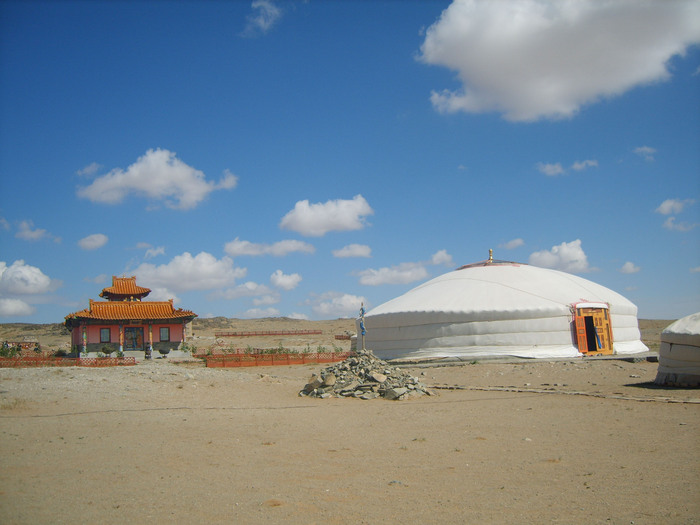
The old monastic capital also had a Geser temple. It originally stood in the Chinese Maimaachen or Maimaa khot, merchant district (Mong. mayim-a / mayimai qota, from Chinese măi mài chéng, merchant town) situated at the east end of the capital and today called Amgalan. From there, it was moved to the east of Gandan hill when a new Chinese merchant district was formed there too, between Züün Khüree and Gandan. It survived the purges and now houses one of the colleges of Gandan main monastery. This temple had a similar Chinese-style main sculpture or mural of Guān dì, which was altered to a Tibetan Geser figure on its horse by the artist D. Danzan lama of Gandan in 1966.
The other type of temple in the Chinese districts was the so-called Erlig Khaan temples or small monasteries. These were named after Erleg nomun khaan (Mong. erlig nom-un qaγan) or, in its Tibetan name, Damjinchoijoo (also written as Damjinchoijil, Mong. damčinčoyiǰil, Tib. dam-can chos-rgyal, “the pledge-holder King of the Dharma,” Skt. Dharmarāja). Another name for this protector is Yama, whose Mongolian name “Erleg” is of Uighur origin, while nomun khaan is the Mongolian translation of the Tibetan term chos-rgyal, “King of the Dharma.” Erlig or Erlik is also found in Turkic, Altaic and Siberian mythology, as lord of the lower world and judge of the dead.
There were two temples with this name in Maimaachen in the old monastic capital and others in other monastic towns with Chinese residents. These were for sure Chinese Buddhist temples, but there is no known account regarding their connection with the Buddhist figure of Yama in Tibetan and Mongolian Buddhism. It is only an assumption that the Chinese equivalent of Yama, Yán Wáng or Yán Luó Wáng, was venerated in them. It is known that a feast was held in them in honor of Erleg khaan annually on Khansh neekh ödör, the day of commemorating the dead (Mong. qangsi negekü edür < üdür), which is of Chinese origin in Mongolia.